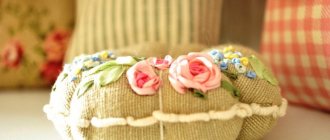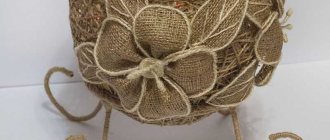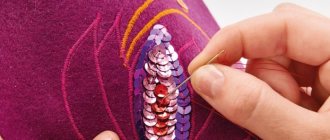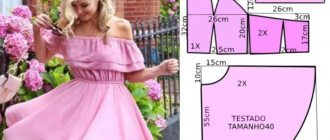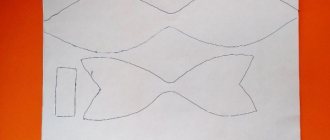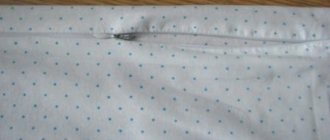Embroidery with satin ribbons is one of the most beautiful types of needlework. In this way you can decorate or update outerwear, summer bags, home textiles and much more. Various flowers will look great against this background. These could be roses, tulips, peonies, poppies or daisies. It is daisies that will be discussed in this article, and you will learn the technique of embroidering them using ribbons.
Embroidery with daisy ribbons step by step for beginners, tablecloth and napkins with wildflower patterns
Floral motifs in needlework have always been very popular. These flowers symbolize lightness and ease, and, of course, simpler than others. This is not strange at all, because they can be used to decorate both clothing items and household items, including bed linen, tablecloths and even curtains.
Embroidering daisies with ribbons is a very interesting activity; this hobby will distract you from your daily routine. It should be noted that the skills will definitely be useful in life to young people who follow fashion and try to stand out from the gray mass. Even old things can get new life.
You need to remember this and not neglect the opportunity to update your wardrobe without a significant investment of time and money.
Necessary materials for the bouquet
Like any type of needlework, it requires some preparation. There is no need to be scared, nothing supernatural is required. It’s just better to put all the necessary materials in one place in advance, so that later you don’t have to go looking for scissors or a lighter.
White petals look very harmonious on a dark canvas color; choose the tone of the base depending on the shade of the walls, if you mean a painting, or on the clothes that will be decorated with an ornament.
If you do not have experience, then draw in advance with a pencil on the canvas the location of the stems, so as not to further distort the image and to guide you in the placement of the elements of the picture.
White ribbons 7 mm wide, green 3 mm and yellow.
Tapestry needle with a wide eye.
Green threads for knitting.
Scissors and lighter.
Today the public strongly encourages this type of needlework and in stores you can find ready-made kits with a set of threads, needles and even a painted ornament on the canvas.
Performance technique
A piece of fabric is inserted into a hoop to make it easier for needlework and determined with a floral arrangement. Such flowers are simpler than other plants, as the picture implies even stitches.
There are more than 22 types in total, but in our case, only two will be required. There is nothing complicated; even novice needlewomen can cope with this task.
Cut off a white one, approximately 30 cm long, pull it through the eye of the needle and stop the needle at a distance of 5 cm from the end. A puncture is made in this place and a needle is pulled through. This way you will secure the piece and it will not slip.
The second end needs to be burned with a lighter so that the threads do not fray and the structure does not unravel. It is created, as mentioned above, with a simple stitch.
It is very important after each piercing of the fabric to correct the embroidery and form the correct petals in your picture.
Many novice needlewomen make the mistake of tightening the stitch too much; ultimately, the fabric underneath will wrinkle and the product will lose its aesthetics.
Repeat the straight stitch in a circle, and then move on to making the middle of the flower. The color used for it is yellow. It is also used to make stitches with a curl.
French knot in daisy embroidery
If you can't do this, as an alternative, use a thick wool thread of the same color and simply sew up the middle. If you have experience and want to make it voluminous, you can decorate the middle with French knots. Knots are made using a simple principle - the needle is twisted around three times and pulled through the canvas. The end result is a neat knot.
When the petals and the middle are ready, you need to move on to the stems and leaves. We make the stems using knitting threads of a dark green or olive shade.
As a rule, the stem of a plant is made with a stem stitch, and with the help of green ribbons (3 mm), the leaves are sewn with a twisted straight stitch. Experienced craftswomen recommend using several shades for leaves in paintings.
This allows you to visually enlarge the picture and make it more realistic.
Stem seam
Twisted straight stitch
Design of an embroidered picture
If you have finished, but still have the feeling that something is missing, you need to improve your work by turning on your imagination. You can complement the picture, for example, with buds.
The base is made with green straight stitches, and the upper part is decorated with white or milky shades. As for their quality, what you will use, then you decide.
Silk ones, of course, will look much more impressive, but their cost is much higher; satin and synthetic options are considered an economical option.
They go well with almost all types of fabric; they can even be used to embroider on leather if you make holes with an awl. Only experienced craftswomen use organza, since the fabric is transparent and the seams must be neat, but novice needlewomen do not always succeed.
After the main components of the picture are ready, decorate with beads, rhinestones, bows or sequins.
If the composition looks unfinished, add flowers of a smaller size and the opposite color. There are no rules in choosing additional flowers, the main thing is that it looks beautiful.
The finished picture is placed in a dark frame, because white flowers in a light frame will look dull.
If you don’t succeed at something the first time, don’t be sad, everyone starts somewhere. Be patient, you will definitely achieve the expected result, and you will certainly amaze your friends with the created composition. With each new job, you will improve your skills and before you notice, you will start giving master classes yourself.
Embroidery with daisies ribbons in a video tutorial
A simple-looking beautiful flower with branches or individual flowers with beads will decorate the entire atmosphere in the hostess’s house on a special day. Embroidery on napkins with ribbon patterns is a wonderful decoration for a festive table. You can embroider this exclusive piece yourself.
Beginning needlewomen who already know how to make the simplest basic ribbon stitches simply must show their skills on tablecloths or napkins. I bring to your attention a step-by-step master class on embroidering a pattern and we will answer the question of what is needed for this, what technique is used to create the patterns and according to what patterns.
Preparatory stage
The pattern can include many different elements to further decorate the tablecloth or napkins. Let's look at what we need:
- cotton, linen or gabardine fabric;
- hoop;
- pencil;
- satin ribbons width – 1.2 cm (white), 7 mm (pink), 4 and 7 mm (green)
- floss threads green and light
- for decoration beads, beads to your taste
- needles with a large eye and regular ones for sewing
- scissors;
Simple scheme
For needlewomen without experience, it is better to start with the simplest patterns, for example, try to embroider a simple daisy flower. To make a beautiful voluminous bud, you will need:
- white, yellow satin ribbons, the width of the strips should be no more than 10 mm; blue canvas;
- needle with a wide eye;
- scissors;
- hoop;
- marker for drawing, it can be replaced with a simple pencil.
After all materials and devices are prepared, you can begin to work directly. The step-by-step technique for doing ribbon embroidery is as follows:
- To begin with, you should draw a sketch of the design that you plan to embroider on a regular sheet of paper, and then carefully transfer it onto the fabric. This can be done using a marker or a simple pencil.
- Now you should choose a convenient place, and embroidery will begin from there. Experienced craftsmen recommend starting with a bud. Place the material in the hoop and you are ready to begin.
- Embroidery begins from the core of the bud; to do this, insert a needle from the wrong side, into which a white satin ribbon is threaded, and pull it through. Then it is necessary to form a petal, moving from the core to the edge, and the strip must lie freely, otherwise the fabric will wrinkle. Moving in a circle, all the remaining petals are embroidered; in the end, an empty core should remain.
- Next, they begin to embroider the core of the flower, this is done using the French knot technique. To do this, you need to take a needle and wrap it twice with yellow ribbon and pull the needle through the fabric. These knots are made until the core is completely filled.
How to embroider Daisies “on legs” with ribbons
This master class is on daisies, which are necessary in embroidery to create a volume effect.
Natasha Koch
Author's Diary
We need: fabric, satin ribbon - my favorite size is 4 mm, green cotton threads for knitting, wire and glue. I draw the centers of daisies on the fabric. On the right is a blank for a bud.
I embroider one version of the chamomile using a pierced stitch: at the desired length of the petal, I pierce the ribbon and pull it out.
I stick the tape into the fabric near where the tape comes out of the fabric.
As a result, we get such a cute daisy. In this way you can simply embroider on fabric.
This is what she looks like from behind.
The second daisy is simply embroidered with loops. The middle is in the form of an oval.
And this is a blank for a bud, we sew it with a simple ribbon stitch, stretch the ribbon.
Here's a general view from the rear.
Take scissors and cut out flowers from fabric. We singe the edge with a lighter (I use gabardine).
We prepare the wire for the legs (bend it in half like this in a loop).
- I collect the fabric with monofilament, stitch it, and sew a loop of wire into the middle.
- This is how the flowers look in person.
- I take the thread and start sewing in a circle, forming a sepal.
- We don’t cut the thread, I dip the wire in glue (I use Gel Moment) and twist the tail of the thread onto the wire.
Here are the almost finished flowers. You can stop at this stage. Paint the centers with acrylic.
But I want to make voluminous centers. We take a padding polyester and a nylon stocking (sock). We cut out a piece of nylon, twist a padding polyester ball, and sew it with monofilament.
- This is what happens.
- I take paints (in the example watercolor, but usually acrylic).
I tint the flowers with gray, blue, and bud green. To do this, moisten the tapes, tint them and immediately dry them with a hairdryer.
- The centers were also tinted yellow-green and yellow-orange.
We use monofilament thread to sew on the centers when they are dry (on the right daisy, I didn’t dry the center enough; the paint leaked a little onto the ribbons). You can sew through the center of the middle, as on the right daisy, and create a dent.
- And this is an example of using such blanks in embroidery.
- Here is a chamomile without a sewn center.
Source: https://www.mastera-rukodeliya.ru/romashki-qa-nozhkah
Daisies embroidery with ribbons in step-by-step lessons for beginners
Embroidery with satin ribbons is one of the most beautiful types of needlework. In this way you can decorate or update outerwear, summer bags, home textiles and much more.
Various flowers will look great against this background. These could be roses, tulips, peonies, poppies or daisies.
It is daisies that will be discussed in this article, and you will learn the technique of embroidering them using ribbons.
Master class with step-by-step photos on embroidering daisies with ribbons
To embroider snow-white daisies, you need to prepare the following according to the list below:
- ribbons made of satin fabric in several colors;
- canvas, needle and scissors;
- be sure to prepare a hoop and a simple pencil;
- matches.
If you want to embroider large buds, then use a wide ribbon for this purpose. Conversely, if you want small flowers, then use narrow satin material. The canvas should have large holes.
Matches are needed to singe the edges of the ribbons to prevent the threads from falling off. You can draw a drawing diagram yourself or choose a suitable one on the Internet.
The length of the satin strip should not exceed fifty centimeters, otherwise it will get tangled and form knots.
Cut one side of the tape diagonally and insert it into a tapestry needle, and scorch the other side with fire. Insert the needle two centimeters from the cut edge and pull it by the long end. Your material is now secured.
Trace your diagram onto the canvas using a pencil or a quick-fading marker. Be sure to insert the material into the hoop. This is necessary especially for beginners who are just starting to engage in such needlework. Rest assured that the work will be much easier with a hoop.
Using straight stitches as shown in the photo, embroider the snow-white petals of this wildflower. If you tighten the ribbon more tightly, then the petals will turn out to have a pointed shape, and if you don’t pull the material too tightly, then the daisy will come out in a lush shape. These are the secrets that will help beginners in the first stages of learning.
The core of the flower is known to be yellow. Therefore, take the appropriate satin ribbons and make French knots in the middle of the bud. Make two curls with a needle, and then bring it to the wrong side of the canvas.
We decorate the stem of the plant in green using a twisted stitch. Bring the needle to your face. side, twist the main material and bring it to the wrong side of the fabric at the required length. All that remains is to embroider the leaves of the snow-white field chamomile.
Rose and basic postulates
On the canvas you need to create five loops that resemble a star. Through these loops we tighten the ribbon in the same color in a circle, but so that it passes either under the loop or above it. As a result, you get a rather beautiful bud, which can be complemented with elegant leaves, beads or beads, which will symbolize drops of dew.
Cobweb rose in 5 minutes in MK, instructions for making amazing roses
Examples of schemes supplemented with lilac branches.
Accessories and materials for embroidery
- Canvas, base fabric
- Hoop
- Ribbons
- Scissors
- Awl
- Multi-colored threads
- Two needles: one tapestry needle with a large eye and the second a regular sewing needle for thread
To begin with, you can use any fabric, color too. For beginners, it is better to take canvas as it is easier to learn. In the future, you can choose a base of better quality so that the composition can decorate your interior or a gift that could pleasantly surprise others. It is necessary to thread it into the stretch, into the hoop. They can be rectangular or round. We embroider a rose from satin ribbon.
This activity is quite simple, the main thing is to have patience. And things that, in your opinion, have outlived their usefulness can be decorated in the same way as in the picture.
You will find one example for beginners in our section. Schemes for creating a future painting can be found on the Internet. Photos of finished products amaze with their magnificence.
We are learning the technique of embroidering snow-white daisies with satin ribbons. How to embroider a daisy with ribbons
HomeSewHow to embroider a daisy with ribbons
Ribbon embroidery helps create three-dimensional paintings and panels. She decorates interior items: pillows, curtains, napkins, tablecloths, as well as clothes and jewelry. The main motif in this technique is floral.
Luxurious roses, careless asters, laconic and stylish cereals, mysterious bouquets of lavender bloom under the hands of craftsmen. Embroidering daisies with ribbons will not cause any particular difficulties even for beginners.
Chamomile flowers are most often embroidered by craftswomen because they look very impressive individually or in a composition: in a bouquet, in a basket. Neighbors of daisies can be ears of wheat, pink clover and cornflowers.
Preparing for needlework
Creating a flower meadow with your own hands is not difficult if you pay a little attention to the selection of materials:
- Embroidery pattern;
- Canvas;
- Hoop;
- Marker;
- Silk ribbons in white and green colors. For petals they will be slightly wider than for leaves;
- Yellow beads;
- Green floss threads;
- A regular needle with a thread of a contrasting color relative to the background;
- Special needles with a large hole.
When starting work, choose the scheme you like, decide how many flowers will be in your bouquet, analyze the proportions of the background and objects.
Daisies can be depicted separately or together with other flowers. A master class for beginners will help you learn how to embroider these beautiful wildflowers.
Let's start embroidering
Use a marker or basting stitches to mark the location for the daisies.
Secure the ribbon to the back of the fabric and use a straight stitch to begin embroidering the petals. Pay attention to the direction of the tape in the photo.
Don’t try to get the petals to be perfectly the same length, let them be slightly different. This will help the flowers look more realistic.
The most common mistake beginners make is to tighten the tape too tightly. The petals should rise slightly above the fabric. This will make the flowers look more voluminous.
Embroider the rest of the daisies in the same way as the first one.
And start with the stem. Fold the green floss thread several times.
Carefully placing it on the outline of the stem marked on the fabric, secure it with needles.
Using a second thread of the color of the stem, pick up the thread fixed on the fabric. Pull the needle out from the inside out.
- You will get a flower stem.
- You should also embroider the remaining stems in your composition.
Then start embroidering the leaves in green, starting from the top. A straight stitch is used here. The photo shows the entire sequence of actions. In the first version, the order of embroidery is clockwise: first one side of the sheet, then the other.
The second method demonstrates embroidering paired leaves. The needle comes out under the tape, which helps make the sheet more dense.
- Embroider all the leaves outlined in the picture.
- And finally, fill the centers of the daisies with yellow beads.
- This is how you can embroider a beautiful bouquet and decorate textiles with it in the interior or arrange it in the form of a painting.
A couple of strokes of the brush
If you confidently draw with various paints, you can tint both the fabric before embroidering and ready-made flowers. For products that will not lend themselves to wet processing, you can use watercolor paints.
To do this, take:
- watercolor or acrylic;
- a glass of clean water;
- several photos showing the colors you plan to modify.
LiveInternetLiveInternet
Source https://sovetotsvet.ucoz.ru This is one of the favorite colors among embroiderers. Chamomile looks noble in field and holiday bouquets, and can be a decorative element on clothes, tablecloths or other products. To make a chamomile, we will need several colors: yellow - white for the middle - green for the petals - one or two shades for the leaves.
Embroidery with daisy ribbons is not difficult. A master class for beginners to work with flowers involves studying the form. Just look closely at the corolla. Round center, even petals diverging in all directions from the inner circle. The petals are rounded at the ends. A simple straight stitch is ideal for embroidering these petals. The recommended width of the ribbon is up to 1 cm. Still, the petals are not so wide. If the daisies are small, then take a thinner tape (6 mm). For large flowers, you can take 10 mm.
Let's mark the place of embroidery with a disappearing marker. We can sew the outline of the flowers with a running stitch.
We fasten the ribbons on the wrong side using one of the methods (methods of fastening the ribbon on the wrong side) and begin to sew the flower with straight stitches. To save tape, you don’t have to return to the middle to bring the tape out to the front side each time. and bring the needle out nearby. Look at the photo - the line shows the course of the tape on the wrong side. With enough skill, without tightening, you can quickly embroider a daisy with ribbons in such an economical way.
Gradually going in a circle, embroider all the petals. What to pay attention to. The petals do not have to be the same length. This will give life to the daisy embroidered with ribbons. This is a mistake that beginners in embroidery often make. The tape does not need to be tightened, it should be raised above the fabric. So the flower will be voluminous.
Using the same stitch we make the opening buds.
Let's make the stems. We take a thread (for example, floss) in several folds. You can take a thicker strand of yarn for knitting in one ply. We lay it in the place where the stem grows.
We bait the pattern with needles.
We bring the same thread from the wrong side to the front side and grab our stem thread.
It turns out to be a stem like this.
You can give position to the threads of the stem by securing it in this way. And again sew with the same thread along the entire length.
Chamomile stems are ready.
Ribbon embroidery of daisies - leaves (Master class for beginners). For them we take a ribbon a little wider than for the petals. In nature, several flower petals can be placed in a chamomile leaf the size of a flower. We will adhere to the same proportion. To embroider a chamomile leaf with a ribbon, we use straight stitches, sharp and simple (like a flower). We fasten the ribbon from the inside and embroider it. We start working from the top of the sheet. Why? So that the bottom stitches overlap the underside of the top ones. This way the sheet will be more uniform, without gaps.
See how to complete the part of the worksheet that has a pair. It needs to be taken out not next to it, but from under the tape. This will also help to avoid gaps.
We can take you out not from under, but from behind. That is, again with this technique we achieve density in the embroidery of chamomile leaves with ribbons.
When threading the ribbon when embroidering a daisy, pay attention to ensure that there is no twisting. Correct them at the first stage, and not after you have already tensioned the tape.
And so we go to the very bottom. One sheet is ready.
Similarly, we embroider other chamomile leaves with ribbon. Well, what is a master class for beginners without the inside out. This is what you often ask questions about. Let's fill our centers with beads and look at the result.
This is how you can quickly and easily embroider a small bouquet of daisies.
Series of messages “=ribbons=”:
Part 1 - MK Printing prints for ribbon embroidery on an inkjet printer Part 2 - THE MOST DETAILED RIBBON EMBROIDERY LESSONS ... Part 22 - How to embroider a butterfly with ribbons. Part 23 - Pillows embroidered with ribbons Part 24 - Embroidery of daisies with ribbons, master class for beginners. Part 25 - Stitches for ribbon embroidery
Embroidery of chamomile with ribbons
Fantasy technology has a rich history. It is easy to implement and allows you to realize any whim of the artist. Embroidering daisies using bright ribbons is the easiest way to master the basics of the craft.
This technique is generally well suited for decorating wildflowers: daisies, poppies, bells and cornflowers, made with ribbons, look surprisingly realistic. You look at the picture and feel how the room is filled with the aromas of fields and forests. The similarity with the living flowers of the ribbon analogues, brought to life by the skillful hands of experienced craftswomen, defies explanation and causes delight.
In general, fantasy technology originates in ancient China and received rapid development in medieval Europe. French kings are fine connoisseurs of original tape art.
Nowadays, unique designer items are again at the peak of fashion. Ribbon embroidery is used to decorate items of clothing and accessories; this technique is used to create panels and paintings that can diversify the most dull interior and give it coziness.
Try to join this art, you will succeed.
Luxurious flowers made from ribbons will “bloom” on any material: cotton, velvet, silk. Beginning needlewomen are recommended to purchase regular canvas or any fabric with large mesh weave for the base.
We will stretch the canvas onto the hoop. For ease of use, purchase a hoop with an adjusting screw. It will help adjust the tension of the base and avoid tightening. You will need special needles with wide ears.
Crafts stores offer a wide range of ribbons for crafts. They come in different types: satin and moire, corrugated and smooth, silk and velvet.
It is better to learn the skill on satin ribbons 50 cm long and 4 mm wide.
Simple stitches - classics of the genre:
- Correctly fasten the tape to the base. To do this, bend the edge of the tape by 2 mm and additionally pierce it with a needle. A “flat knot” is formed. Proper fastening of the tape will help to avoid additional volume from the “wrong side” of the work.
- We master the basic stitch “Forward needle”. Learning to adjust the length and tension of the stitch.
- The width of the Japanese stitch can vary from one to four centimeters.
- The French knot is a basic stitch in the ribbon technique. A ribbon is wrapped around the needle in 2-3 layers and a neat knot is obtained.
Having mastered the basics of craftsmanship, it will not be difficult to combine different types of stitches, creating real masterpieces.
Master class on daisy embroidery with detailed photos
Suitable for beginner craftswomen.
Materials for work:
- Hoop;
- Canvas;
- Scissors;
- Simple pencil;
- Special needle;
- Satin ribbons;
- Lighter.
Procedure:
Draw a sketch of a flower with a pencil. We cut off one end of the ribbon and burn it to avoid thread shedding.
We cut the other tip diagonally and thread it through the eye of the needle. We secure the tape with a “flat knot”.
We embroider chamomile petals with ribbons using straight stitches. If you pull the tape tightly, you will get sharp-angled petals. A slight tension will give the chamomile fluff and volume.
We will decorate the heart in yellow with a French knot.
We embroider the stem with a “twisted stitch”. We twist the tape on the “face” of the work and bring it to the “wrong side”.
We decorate the leaves with a sharp “Japanese” stitch.
The chamomile embroidery is finished.
We embroider cornflowers with satin ribbon. Materials for work:
- Satin ribbons in blue or blue;
- Green satin braid 3mm wide;
- Blue and purple floss threads;
- Hoop;
- Scissors;
- Special needle;
- Canvas.
Procedure:
Let's make a sketch on the fabric. First, draw a circle of the required diameter. Let's divide it into 8 parts. In the center we select a circle - the middle of the flower. The scheme is ready.
We embroider the flower petals with three stitches. It is necessary to perform segments of different lengths. The stitches start at one point and spread out in “rays” to the sides. should be longer than all the others.
We decorate the cornflower center with floss threads. We form the base of the flower using a large loop. We twist the green ribbon as tightly as possible, we get a neat stem.
Work on the cornflower has been completed.
Poppies. Materials for work:
- Nylon tape, corrugated;
- Material is the basis;
- Hoop;
- Scissors;
- Tapestry needle;
- Bugles are black.
Operating procedure:
We take 70cm of nylon tape, thread it into a needle, and stretch it to the front side of the work. We make a seam along the entire length of the tape. Let's make transverse seams for the constrictions of the flower petals.
We carefully tighten the thread, giving the poppies their natural shape. We form flowers by laying out the ribbon in a spiral and securing it to the fabric. We fill the center of the flower with a “French knot” using green satin braid, and sew on black bugles.
We embroider green twigs and leaves from green satin braid. The poppies turned out great.
If you have mastered the embroidery of individual flowers, you can begin to create a large-scale canvas. This is the kind of bouquet of wildflowers in a basket that a professional craftswoman can embroider.
Watch video lessons and improve your skill level
Source: https://sdelala-sama.ru/vyshivka/1862-vyshivka-romashki-lentami.html
Embroidery with satin ribbons: do-it-yourself daisy
We offer you a simple step-by-step master class on embroidery with satin ribbons: we will make a beautiful daisy from ribbons with our own hands. In this master class, embroidery is done on satin fabric, but this point is not fundamental - you can use any natural or synthetic fabric, denim, and even coarse dense fabrics like velvet or fleece as a base.
Floral decor is a great idea for decorating certain wardrobe items, accessories, and household items. Using satin ribbons, you can embroider hats, bags, skirts, tops, blankets, and much more in a very simple way. Another idea is to decorate the covers of various albums and notebooks. Embroidery with satin ribbons can also be done on cardboard.
What do we need?
- base fabric
- hoop
- satin ribbon 1 cm wide
- satin braid 0.5 cm wide
- needle with a very large eye
Selection of fabric for the base
Embroidering flowers with ribbons may seem difficult for beginners. Therefore, you should start learning from the basics. To make flower embroidery with ribbons high-quality and beautiful, you must first select the right tools and materials for the work. The result primarily depends on this.
It is very important that the base fabric on which flowers will be embroidered with ribbons is strong enough, because the stitches must be securely fixed. But we should not forget that the material should easily allow the needle and ribbon to pass through
Most often, craftswomen use tapestry, linen, and embroidery canvas.
Sometimes a color design is already printed on the canvas. It is very easy to embroider flowers with ribbons - no patterns are required in this case.
